MISCELLANEOUS
Below are some of the projects that I have worked on in the past. This page is no longer being updated, so for latest information about my work please visit the Wikitopia Project website.
以下は過去に携わってきたプロジェクトの一部です。このページは現在更新されていませんので、最新の研究内容についてはWikitopia Projectのウェブサイトをご覧ください。
ATLAS OF FUTURE CITIES
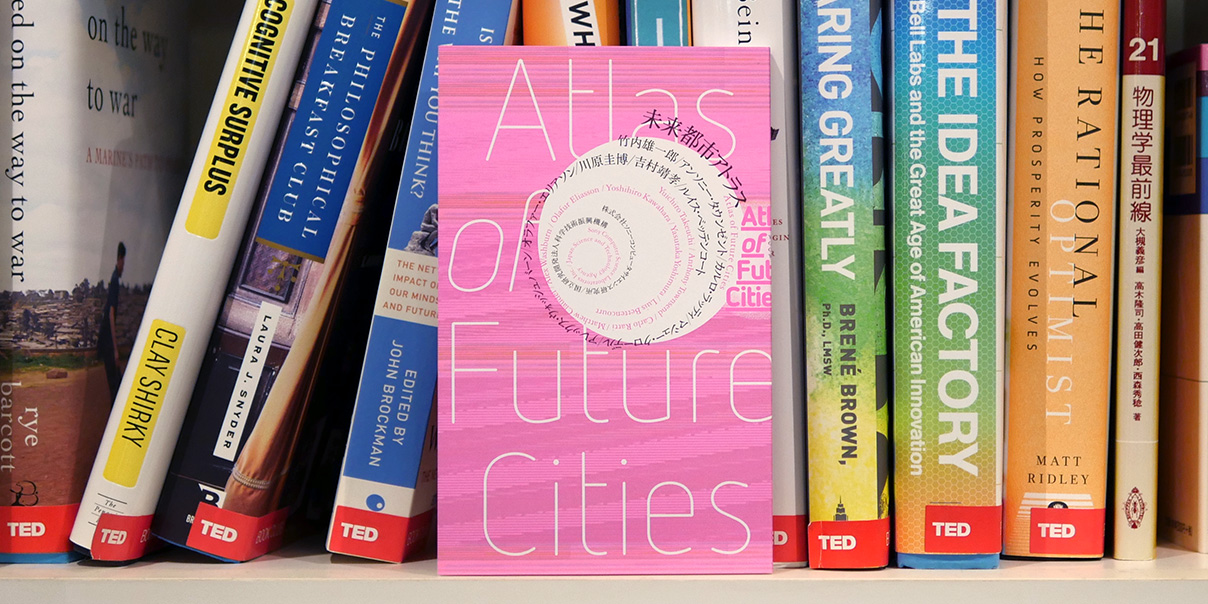
Atlas of Future Cities is a collection of essays by an international group of researchers and practitioners, each discussing the possible effects of emerging technologies on 21st century urbanism. The booklet was produced with financial support from Japan Science and Technology Agency (JST), and was published on March 1, 2017.
Essays written by: Yuichiro Takeuchi, Anthony Townsend, Carlo Ratti, Matthew Claudel, Alex Washburn, Olafur Eliasson, Yoshihiro Kawahara, Yasutaka Yoshimura, Luis Bettencourt
Edited by: Yuichiro Takeuchi, Jiro Iio, Hinako Izuhara, Toru Horiguchi, Shin Akiyama
Atlas of Future Cities(未来都市アトラス)は新しい科学技術が今後どのように都市を変えていくかというテーマで、様々な分野の研究者や実務家に寄稿いただいた文章をまとめた冊子です。科学技術振興機構(JST)の助成を受けて制作し、2017年3月1日に発行されました。
執筆者(敬称略): 竹内雄一郎、アンソニー・タウンゼント、カルロ・ラッティ、マシュー・クローデル、アレックス・ウォッシュバーン、オラファー・エリアソン、川原圭博、吉村靖孝、ルイス・ベッテンコート
制作チーム(敬称略):竹内雄一郎(監修)、飯尾次郎 + 出原日向子(編集・DTP)、堀口徹(翻訳協力)、秋山伸(デザイン)
CLAYVISION
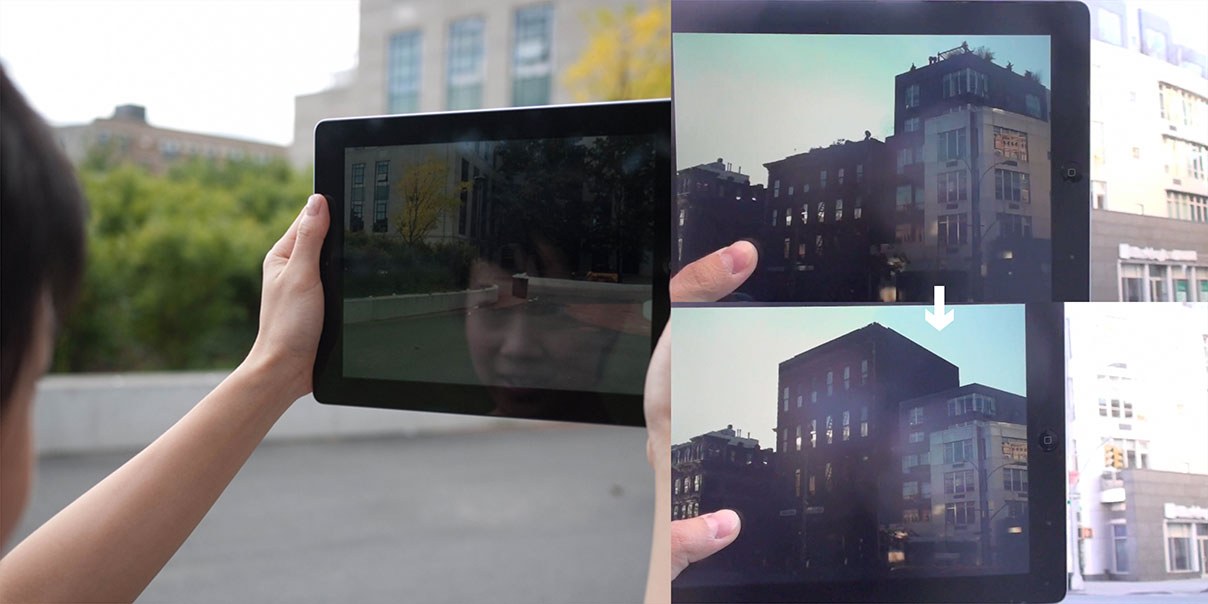
ClayVision is an augmented reality system for mobile devices, that overlays digital information to cities not through the conventional approach of placing virtual panels, arrows, etc., but through real-time transformations of the built environment. Users of the system can dynamically redesign the city according to their needs and preferences; for example, heights of nearby buildings may be adjusted to reflect Yelp ratings when looking for restaurants.
In collaboration with Ken Perlin.
都市の自由変形を可能にするスマートフォン・タブレット用の拡張現実システムです。環境に仮想的な看板や矢印などを次々と貼り付けていく従来の拡張現実とは異なり、建物や道路の見た目を動的に改変し、リアルタイムで都市空間の再デザインを行うことを可能にします。たとえば街中でレストランを探す際に、目に見える範囲のすべての建物の高さを「食べログ」の点数に合わせて伸び縮みさせるなどといった使い方が可能です。
Reference:
• Takeuchi, Y., Perlin, K. ClayVision: The (Elastic) Image of the City. In Proc. of the 30th ACM Conference on Human Factors in Computing Systems (CHI 2012). pp.2411-2420. Best Paper Award. Download (PDF, 3.9MB)
PARALLEL CITIES
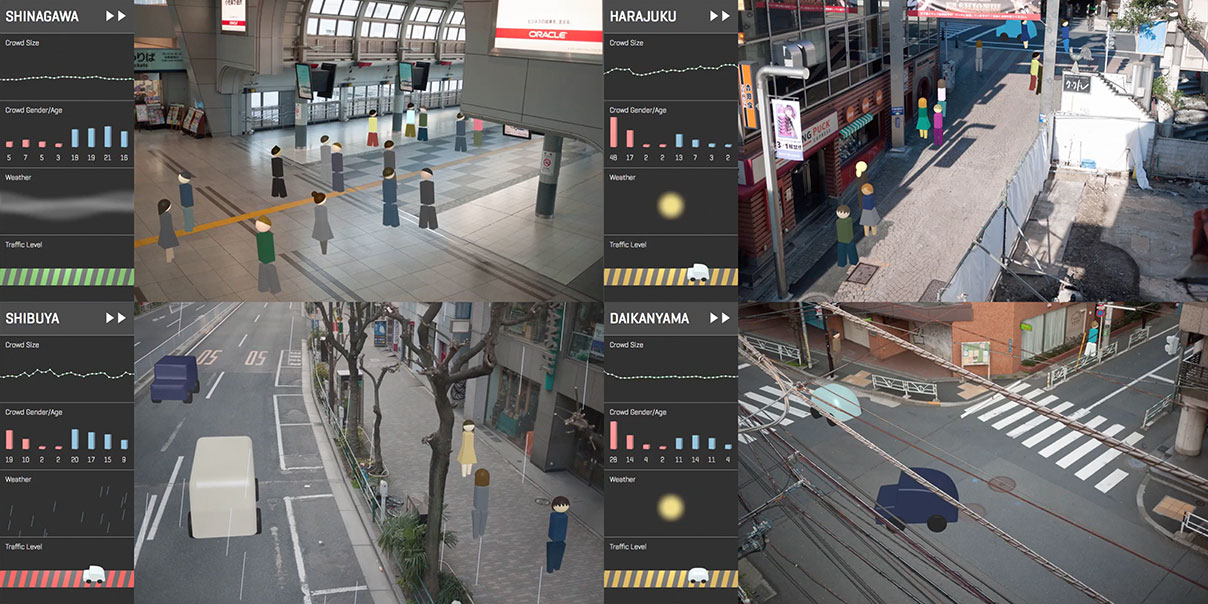
Parallel Cities are live urban simulations that are consistently kept "true to life" by analyzing real-time information such as SNS feeds. The simulations are densely populated with people and traffic, whose behaviors may deviate from reality in their microscopic details, but are largely faithful at the coarse, macroscopic level. The user experience is comparable to having the power to freely open "windows" to arbitrary locations in the city. Part of the code was also used in MIMMI.
SNSフィードをはじめとした複数の情報を解析することで都市の各地点の状況を推測し、任意の場所の映像をリアルタイムで生成できる「どこでも窓」システムです。天気予報をチェックするような手軽さで、街の現在の状況を確認できます。映像は、個々の人や車の動きなど細かい部分では正確でないものの、場所ごとの群衆の規模やその年齢構成、交通状況などマクロレベルでは実際の街の様子をある程度正確に反映します。コードの一部は、MIMMIにも利用されました。
Reference:
• Takeuchi, Y. Parallel Cities. In Proc. of the 19th ACM Symposium on Virtual Reality Software and Technology (VRST 2013). pp.89-92. Download (PDF, 2.0MB)
MIMMI
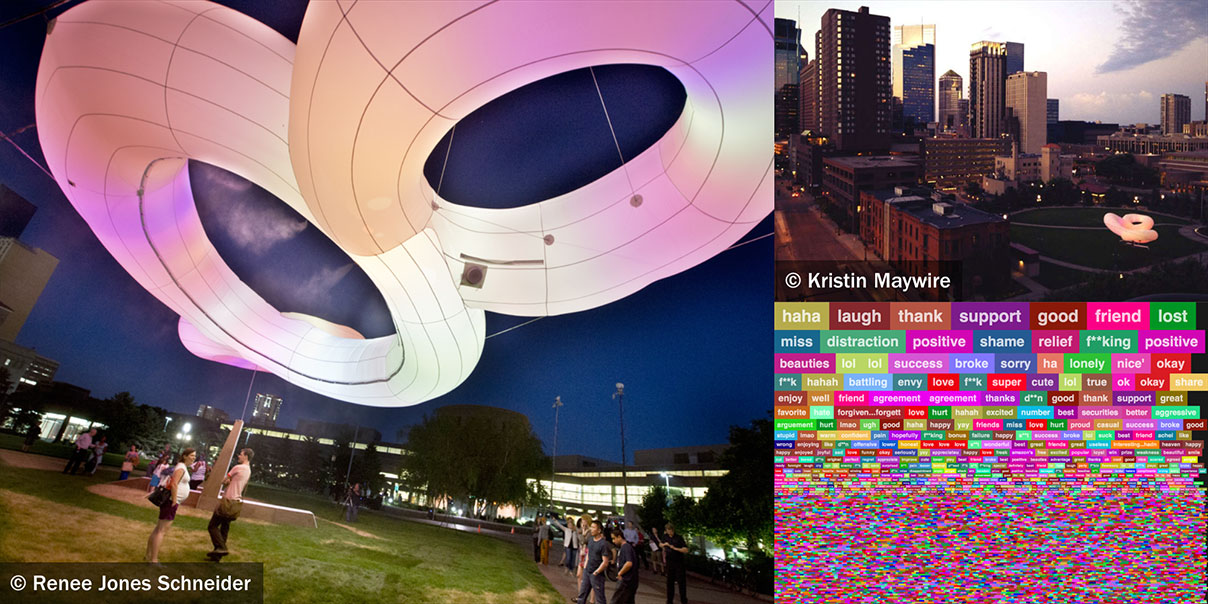
MIMMI is a large-scale interactive installation set up in Minneapolis, USA during the latter half of 2013. The installation continuously analyzed the collective "mood" of the city by mining Twitter feeds, and expressed it using light, mist and sound. The project was carried out by an international, cross-disciplinary team of experts; I was in charge of developing the digital components. The piece was a finalist for the 2015 Architizer A+ Awards.
In collaboration with Bradley Cantrell, Jack Cochran, Carl Koepcke, Peter Mabardi, Artem Melikyan, Allen Sayegh and Ziyi Zhang.
2013年の後半、米国ミネアポリス市に半年間設置された大型インスタレーションです。Twitterを解析して割り出したその時々の街の「気分」を、光や音、霧によって表現する構造物です。建築家やデザイナーとの共同制作で、私は技術面を担当しました。先端技術を応用した独創的な建築物として、2015 Architizer A+ Awardsに入賞を果たしています。
WEIGHTLESS WALLS
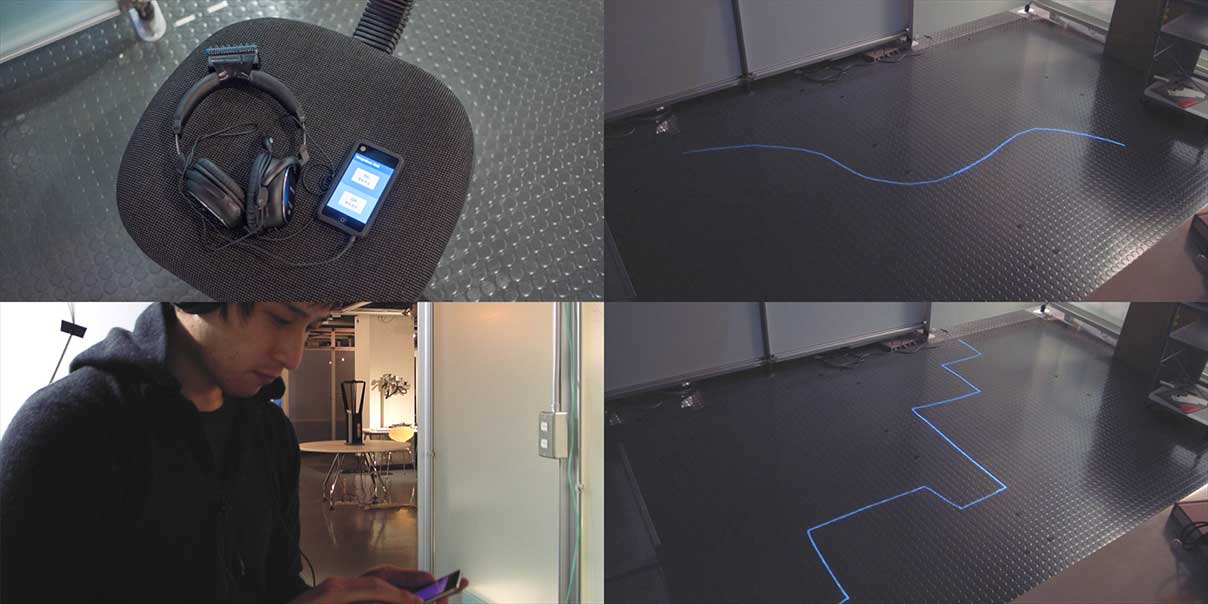
Weightless Walls are invisible, sound-blocking walls that can be created anywhere in a room. Users wear custom headsets that allow them to engage in VoIP-like, but "spatially faithful" conversations with each other. As the headsets block any natural sound entering users' ears, the setup allows all conversations between users to be mediated by a central server, which performs real-time audio processing to produce sensations of virtual walls. The system is intended for use in open-plan offices, enabling workers to freely create acoustically isolated regions to have quiet meetings, presentations, etc.
音を遮る見えない壁を、室内の自由な位置に作り出すことのできるシステムです。ヘッドセットを装着したユーザには、プロジェクタによって床に投影された線が音のみを遮る壁として知覚されます。壁の同じ側にいるユーザとは(ヘッドセットを着けていないときと変わりなく)自然に会話することができますが、壁の向こう側にいるユーザの声は聞こえなくなります。オフィス空間での利用を想定しており、従業員が必要に合わせて個室やミーティングルームなどを自在に生成する、新しい職場空間の形を生み出します。
Reference:
• Takeuchi, Y. Weightless Walls and the Future Office. In Proc. of the 28th ACM Conference on Human Factors in Computing Systems (CHI 2010). pp.619-628. Download (PDF, 3.0MB)
WHIRLSTOOLS
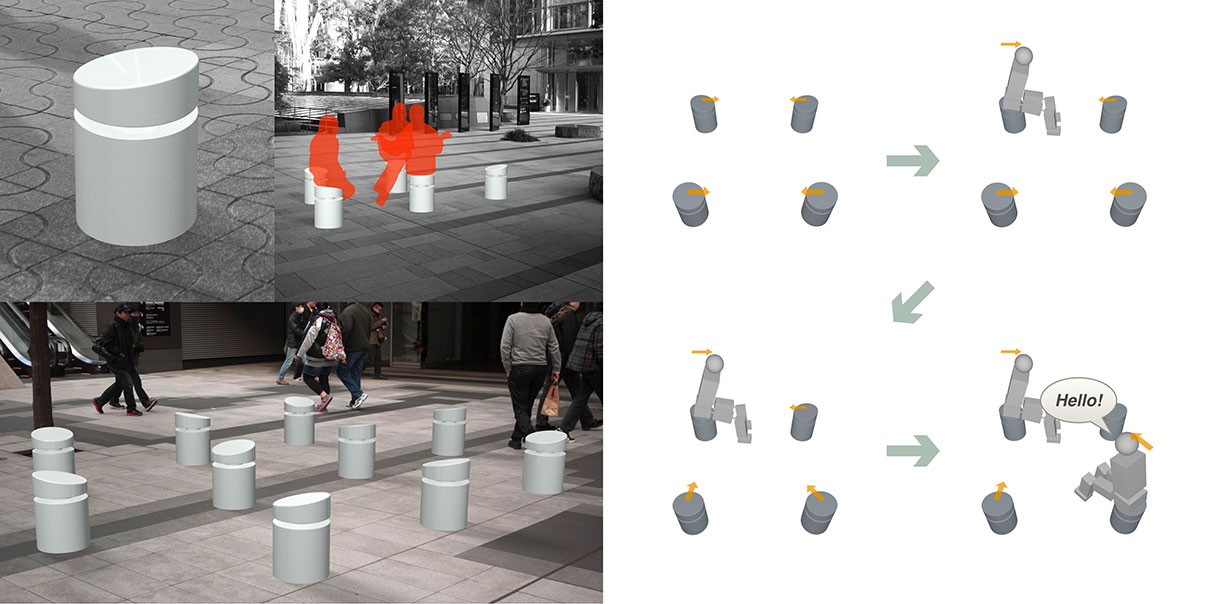
Whirlstools is a concept for kinetic street furniture that encourages spontaneous communication in public spaces. When a slight angle is added to the top surface of a cylindrical stool, sitting in one direction becomes more comfortable compared to others. By dynamically adjusting the orientations of vacant stools, the furniture implicitly steers people into sitting face-to-face with one another, raising the likelihood of social interactions.
In collaboration with Jean You.
公共空間におけるコミュニケーションの促進を目的とした、パブリック・ファニチャーのコンセプトです。円柱上の椅子の上面に緩やかな傾きをつけると、ある方向には座りやすく、他の方向には若干座りにくくなります。このことを利用し、空いた椅子の向きを回転機構を用いて動的に調整することによって、人々が互いに向かい合って座るよう無意識的な誘導を行います。
Reference:
• Takeuchi, Y., You, J. Whirlstools: Kinetic Furniture with Adaptive Affordance. In Ext. Abst. of the 32nd ACM Conference on Human Factors in Computing Systems (CHI 2014). pp.1885-1890. Download (PDF, 2.8MB)
GILDED GAIT
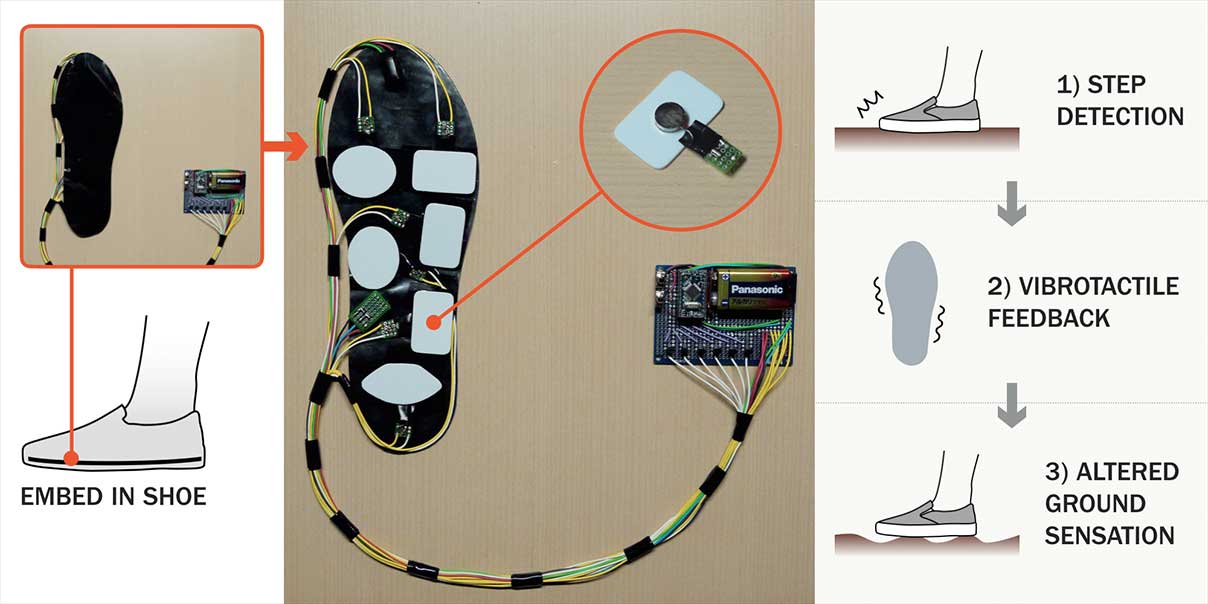
Gilded Gait is a pair of haptic insoles that transforms perceptions of ground texture using vibrotactile feedback. The device is primarily intended to be used for urban navigation — users can assign distinct virtual ground textures to arbitrary streets, regions, etc. The device relies on principles similar to that of haptic feedback for touchscreens.
地面の感触を変えるインソール型のウェアラブル・デバイスです。屋外でのナビゲーション用途を想定しており、たとえば目的地までの道のりすべてに仮想的な凹凸のタイル(歩道や駅に設置される点字ブロックのような)を敷き詰めることなどが可能です。タッチスクリーン用の振動フィードバック技術を応用したデバイスです。
Reference:
• Takeuchi, Y. Gilded Gait: Reshaping the Urban Experience with Augmented Footsteps. In Proc. of the 23rd ACM Symposium on User Interface Software and Technology (UIST 2010). pp.185-188. Download (PDF, 1.4MB)
ACM ISS 2018
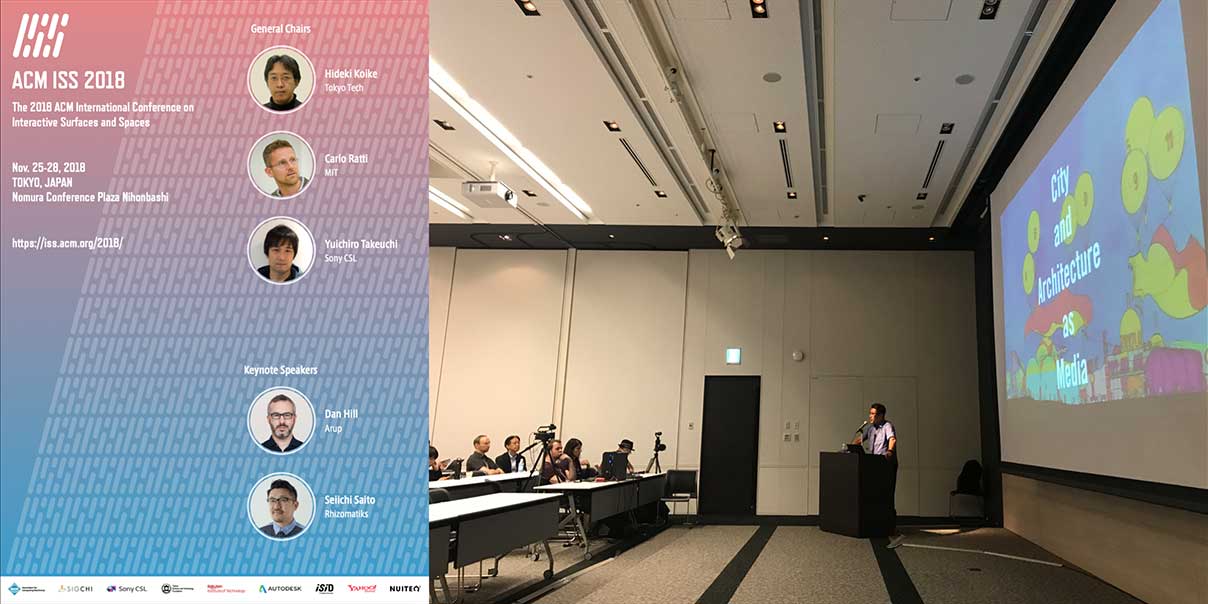
I co-chaired the international conference ACM ISS 2018 (The 2018 ACM International Conference on Interactive Surfaces and Spaces), held in Tokyo, Japan in November 2018. I also designed the logo!
2018年11月に東京で開催された国際会議、ACM ISS 2018(The 2018 ACM International Conference on Interactive Surfaces and Spaces)の運営委員長を務めました。ロゴやポスター等のデザインも担当しました。
REMEMBERED PRESENCE
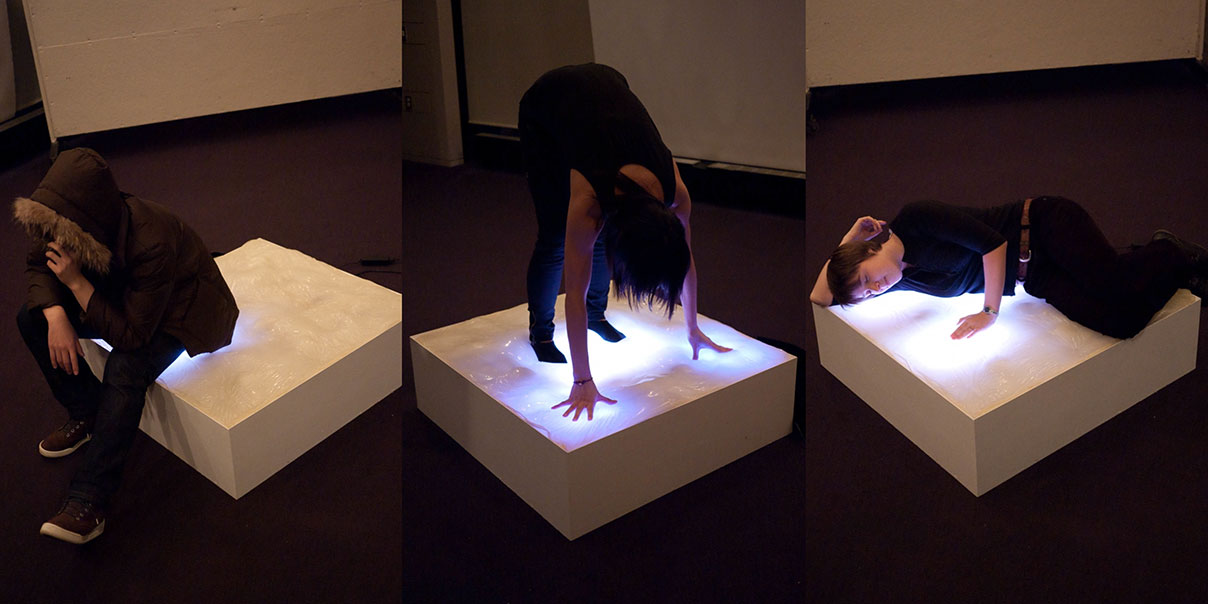
Remembered Presence is a responsive furniture that captures traces of interactions through color change and physical deformation. Memories of human presence are temporarily left behind as glowing silhouettes of light.
In collaboration with Helena Slosar and Melissa Kit Chow.
座った人の痕跡を、表面の形状変化と光のシルエットによって一定時間だけ残す家具です。
Reference:
• Howeler, E. (Ed.). GSD Platform 4. ACTAR, Harvard Graduate School of Design. 2011.
CLOCKZILLA
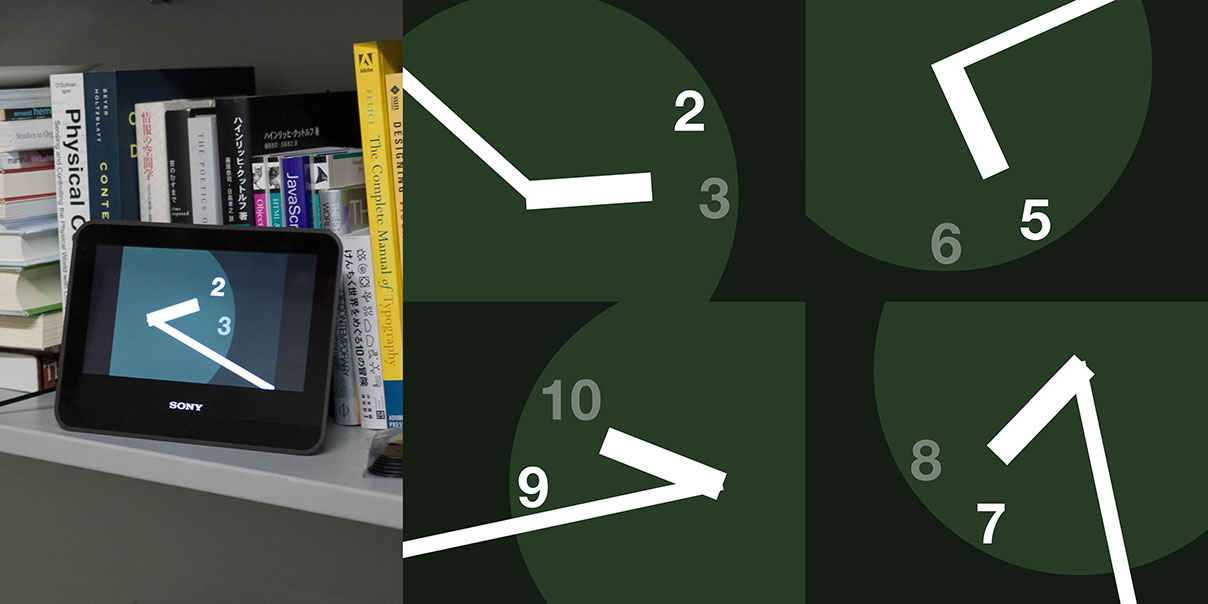
Clockzilla is a clock widget for the (now discontinued) Sony dash, designed so that nearsighted people can easily read the time. The widget tries to make the clock face appear as large as possible, by only showing parts that are necessary to read the current time.
現在の時刻を読み取るのに必要な部分だけを拡大して表示する置き時計です。近視の人でも簡単に時間がわかります。自宅で使っていますが思った以上に便利なので、いずれRaspberry Piなど安価な部品の組み合わせで作り直して、Web上で作り方を公開したいと思っています。
EDOSHOP
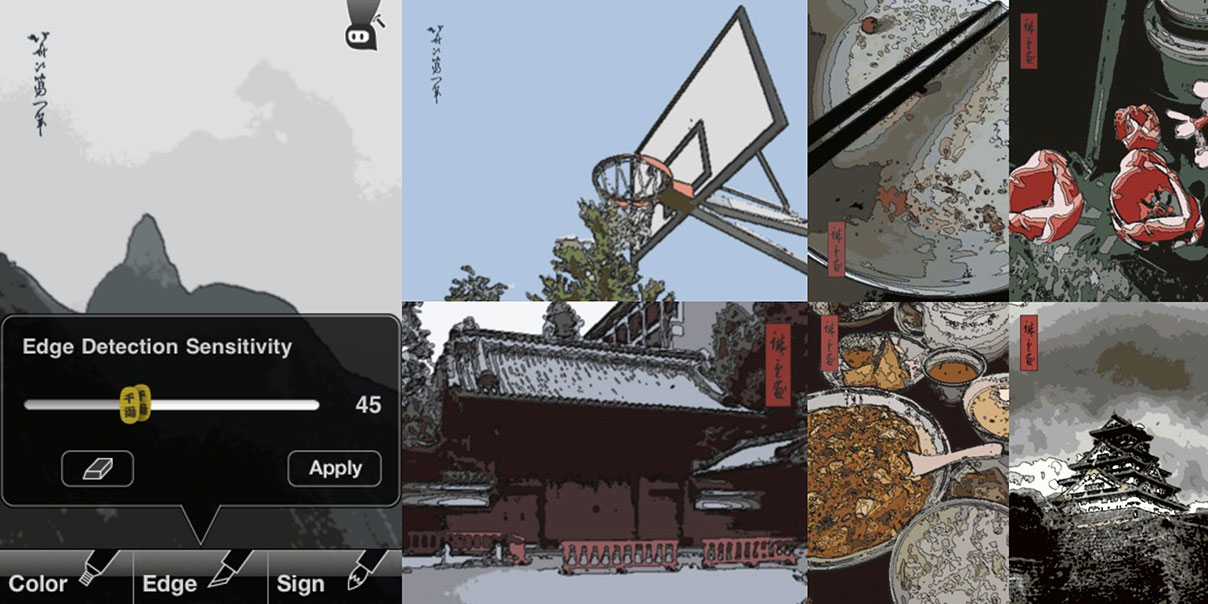
Edoshop is an iPhone app (no longer available for download) that turns photos into ukiyo-e style images. The app reached 4th place in the Japanese iTunes Store Free App Ranking.
写真を浮世絵風(?)に加工するiPhoneアプリ(2009年公開、現在は非公開)です。iTunesストアの無料アプリランキングで一時期4位まで浮上しました。
CITYVOYAGER
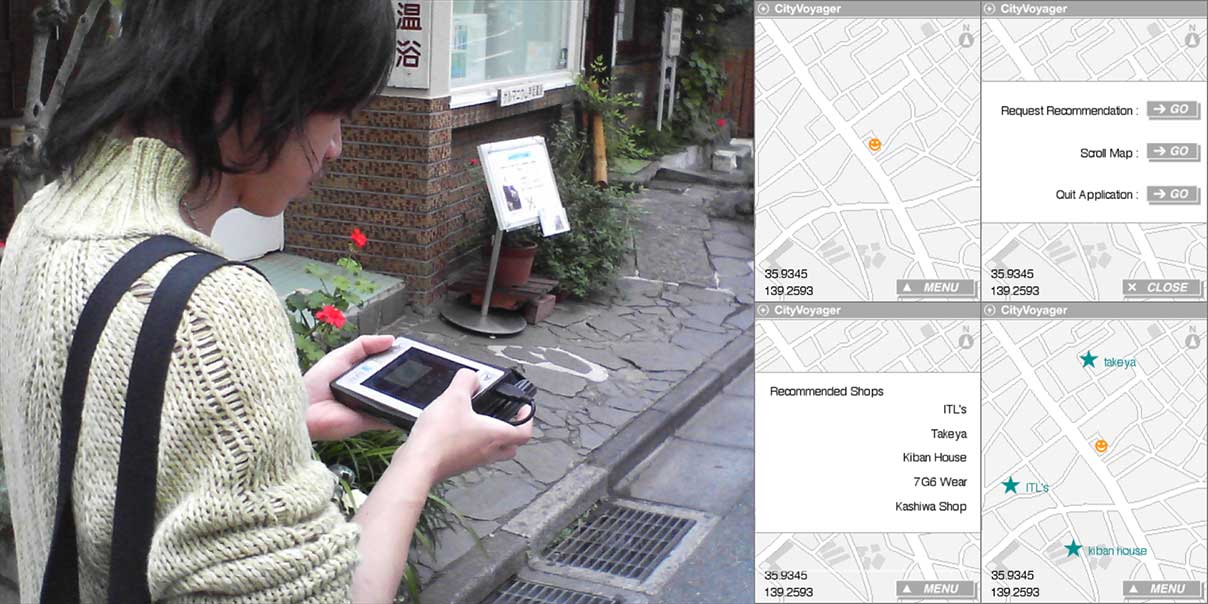
CityVoyager is an intelligent city guide that provides customized shop recommendations to users. Users' preferences are estimated by analyzing their long-term location history. The project became part of my PhD thesis, which explored different ways in which digital systems can be made to adapt to individual lifestyles. My earliest published research project!
長期的な位置情報の履歴を解析することでユーザのライフスタイルを学習し、それに基づいて店舗の推薦を行うスマートな街案内システムです。東大の大学院では、ユーザに合わせて適応し進化する情報システムを作る様々な手法について研究していて、これ以外にもいくつかのシステムを試作しました。
References:
• Takeuchi, Y., Sugimoto, M. A User-Adaptive City Guide System with an Unobtrusive Navigation Interface. Personal and Ubiquitous Computing, vol.13, no.2. pp.119-132. 2007.
• Takeuchi, Y., Sugimoto, M. CityVoyager: An Outdoor Recommendation System based on User Location History. In Proc. of the 3rd International Conference on Ubiquitous Intelligence and Computing (UIC 2006). pp.625-636.